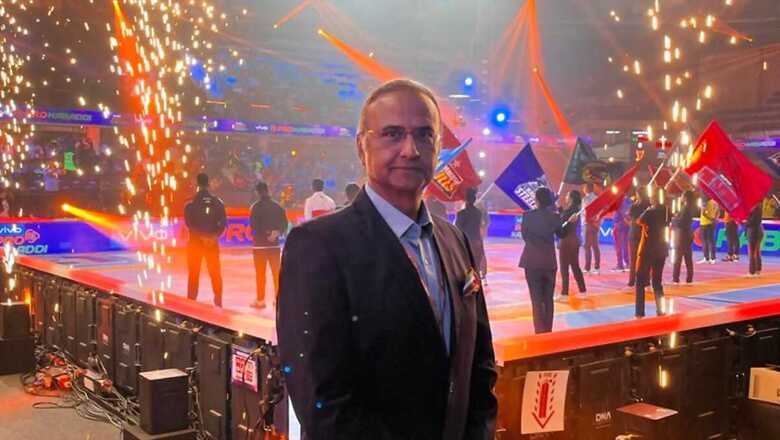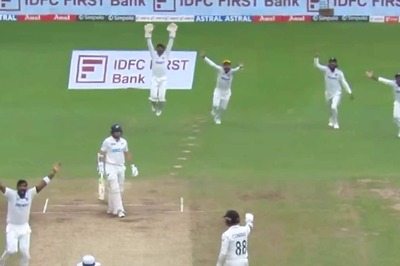
views
Pro Kabaddi League has had immense success over the years, not only is it India’s second most-watched league behind only the Indian Premier League (IPL), but PKL has completely revitalised the sport. Names such as Anup Kumar, Rakesh Kumar and Manjeet Chillar became household names.
What started in 2014 as a big experiment, the PKL ended up giving the Indian sport of Kabaddi a new lease of life. The juggernaut has since rolled on going through its fair share of highs and lows and now it’s set for the 10th edition later this year.
With PKL set to complete a decade-long journey, News18.com caught up with the founder of the league and member of the technical committee, Charu Sharma. The renowned commentator shed light on the roots of the Pro Kabaddi League that go all the way back to the 2006 Asian Games. It took Charu eight years to get PKL up and running and even though there have been plenty of ‘turbulences’ along the road, Kabaddi has seen immense success over the years.
In a freewheeling chat, Sharma talked about the evolution of PKL, the decade-long journey, and how the league is planning its next big step.
Excerpts:
The Pro Kabaddi League, the second biggest spectacle in India after the IPL, revived the sport of Kabaddi, how did the revolution begin?
My reconnection with Kabaddi was when I was asked to do commentary for the Asian Games in 2006. I could sense the power and popularity of the game but for some reason, it hadn’t reached mainstream. When I came back and I talked to Anand Mahindra, I told him it’s a fantastic game, we should take it forward. Strangely for the next 4 years not much happened. Sometimes things take time, then I was asked to do commentary again in the 2010 Asian Games. I felt bad at the time, it’s our own heritage game, if we don’t take it forward who will?
So I came back and talked to Anand again, I said let’s do it, and the difference between 2006 and 2010 was that in 2008 the IPL started. The IPL caught the nation’s fantasy, Anand then suggested listen why not we do a Kabaddi league? Of course, to do a league without a major setup was like sending a rocket to the moon with a little stick in hand. I said let’s do a league, so we went back to the Federation and long story short that was the birth of the Pro Kabaddi League.
Were there any challenges you came across while setting up PKL since IPL was the only recognized franchise league in India back then?
Everything was a challenge! The Hockey League had just started and didn’t do well, despite all the support and it was an eye-opener. It was a big red flag, but I said Kabaddi is going to work, it’s very easily televisable in a watchable way. Everything was a hurdle, the federation was very kind and generous, we had a very good trust but even then it took very long. They said well you’re not getting it going, and I said it’s gonna take time. It was my crusade, my single-minded push that we have to get it going.
The next challenge was to get the franchises, I lost a lot of friends, because there I was saying to people why don’t you take a Kabaddi team, and people were like ‘Charu Sharma has gone mad’. There was a lot of discouragement which is normal for any such revolution. The organisation of players, they were all there but these were easy challenges, the partnerships were the really difficult challenges.
PKL started in 2014, and now it’s going to have its 10th season, the league is getting bigger and better with each season if you could shed some light on the years gone by?
I always knew that the world of Kabaddi would change forever from Day 1 because people would see as I called it a ‘sophisticated, international competitive new avatar of Kabaddi’. People suddenly woke up to the power of the game, the organisational part was lacking before and people were very shocked to see this international sophisticated offering. The first and immediate reason for the success of PKL was that it was given a ‘blockbuster’ opening.
If it had a tepid and average start, maybe we would have never reached the heights. And you may ask why Kabaddi, first because we wanted to give it back the respect, it’s our sport if we don’t take it forward who will?
Also of course the first set of people to benefit from it were these fantastic athletes who played the game. They’re crazy super stuff, and after all that hard work, they got no support. My heart bled, and all that certainly happened. The sport got ‘revitalised’. This journey has been fantastic, the way Mashal Sports and Star have managed the turbulence along the way. Even the way how the event was held in the Covid period, and then we increased the number of teams after the third season it was a very necessary and bold move.
After ten seasons and multiple innovations what next steps do you think could be taken to take PKL to the next level? Can we expect more franchises to join the bandwagon? Or perhaps games outside of India to increase the sport’s popularity?
More teams? Absolutely because in India we have a big geography and we have large pockets of people in different parts of the country there is scope to get more teams. I think we need to consider the sustainability, the PKL has sustained fabulously. So many other leagues have come and gone sadly but the PKL has sustained magnificently. So more teams yes, I think India can absorb a minimum of 16, maybe a maximum of 20. I think it will happen eventually but we need to make it grow organically. Also, there is a limitation in terms of quality international indoor stadiums, we’ll need that, we can’t hold it in areas where the internationalism being showcased is not possible.
We are not as strong commercially as I would like it to be, and once that happens I’m sure that will be a catalyst in getting more teams going because then it will be a longer season, more teams, more people involved.
I was very greedy about pushing Kabaddi internationally but that has been put on the backbencher. No doubt that the next big step is to take the league or a portion of the league in neighbouring countries to begin with and then further away.
Do you feel now that the PKL has been around for a decade, the Women’s Challenge could be reintroduced?
There’s only one or two small challenges that need to be solved, in Kabaddi the court size is different for men and women and with all the changes it’s not practical. Either we increase the size of the women’s court, and the jury is out regarding that aspect, and if we can’t, it’ll have to be a separate tournament.
So there are a couple of challenges which don’t have easy solutions, will there be a solution, of course! And will we get a women’s league? Absolutely! We first need to make sure that those challenges in no way take away from the power of women’s Kabaddi.
With the Asian Games this year, the PKL schedule is likely to be adjusted accordingly, could you tell us a little bit about when season 10 could commence and whether the league could return to all the 12 venues this year?
Every Asian Games year is a problem for the PKL because we can’t have a league in two halves, we need to shift our schedule in an Asian Games year. Normally we have the league between July and September but now we have to go to the winter. I think in an Asian Games year it may be wiser to have fewer venues, the final decision is still to be taken. Personally, 12 venues is the way to go, we can’t go home and away because commercially it’s far more expensive. This year maybe 12 venues could be a far stretch.
What started with IPL, PKL and now more than 15 different franchise leagues across sports have come up in India, how do you see the ecosystem developing, and what is the road ahead for franchise leagues in India?
The international reputation and respect of a nation is associated with its sporting success. When we do leagues and sports events which are very big in other countries that’s a challenge. If we’re doing a sport where we’re ranked 94th, the standard that we’re showcasing is an uphill battle. We also have access to watch the best sport around the world, and then it becomes difficult to watch the 94th best, but what we can do is create a product that has an international sophisticated look and feel. People can dispute your standard is not the best, but they can’t dispute the fact that it’s a great offering.
Because otherwise, we may not be able to earn the respect of the watching world. Commercially, there’s a lot of catching up for corporate India to support all the rest of the sports. They need much more support, there’s a lot more government support, but the ultimate support from corporates, we’re well behind in that. Once that circle catches up, all these leagues will do much better than they already are.
















Comments
0 comment